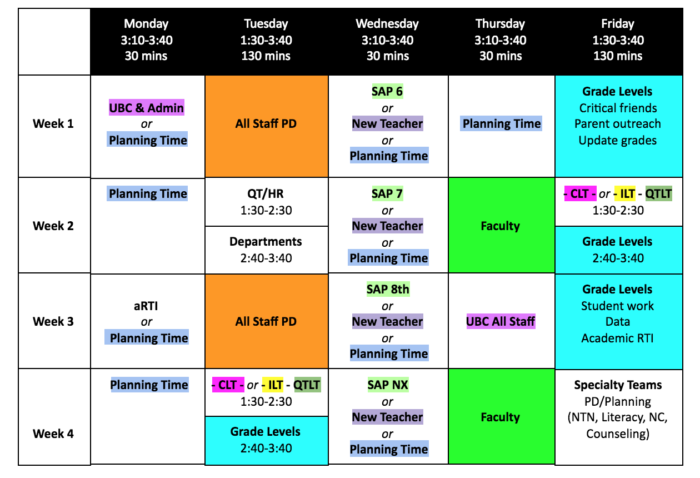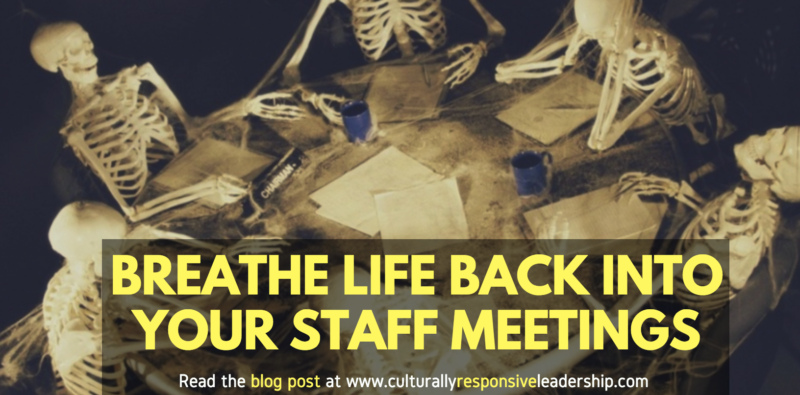Breathe life back into your staff meetings
If we are ever to bridge the opportunity gap and eradicate educational disproportionality, we need to make big changes. Readers workshops, project-based learning, and technology integration. Culturally responsive teaching, social-emotional learning, and restorative justice. Those are big ole changes!
These shifts require us to build capacity through some form professional development. No one wants another meeting, but we need to learn to work smarter, not harder. Especially if we want different outcomes.
So what do you do?
Our meeting spaces need to be high powered, collaborative, and flexible. But you only have so many minutes in the contractual workday.
What gets in the way of quality PD
- Lack of extended time
- The need for instructional minutes
- Too many initiatives, breadth over depth
- Not all staff play well with others
- Lack of norms and structures

We can’t do It all in an hour
We’ve all tried it or sat through this. PowerPoints. Guest speakers. Rushing to pack it all in. Ever heard someone say, “Ok this reading should take 30 minutes, but you can just skim it in 10 minutes.” You want to say, no fool, I want to read it all if I am supposed to learn something here. To save time, you skip bathroom breaks or skip the icebreakers and it starts to just feel like a business. Then, you just get to a good part and it is time to wrap it up.
If you are facilitating, you look at the clock but the bell is about the ring. Students are walking past the library looking in the door, and you realize no one is supervising the halls.
Staff gets up and you yell, “Ok, see if you can implement this in your class and remember…” but no one hears the end because they are out the door and getting ready to teach 1st period. That ain’t working for nobody, but it’s more common than clock speakers that don’t work in classrooms.
So if you can, restructure to add more collaboration time!
What could you do with the extended Common Planning Time?
- Look at student work
- Use a critical friends protocol
- Use a ROCI, PDSA cycle, or revisit SMARTE goals
- Bond and build community
- Hold a book study
See 6 habits of highly innovative schools
What types of meetings are there?
- Faculty business/logistics meeting (put it in an email if possible)
- Professional Learning Communities
- Traditional Sit and Get PD (boring)
- Department and Grade Level Team meetings
- Differentiated Workshops
- Co-Teacher planning
- Student Support Team

Where’s the equity?
Good, you have better meetings, but how does that move you to equity? For starters, make sure that data is a large part of your meetings. Revisit your goals, bring our some student work and determine if all groups of students are achieving. Bypass the conversation about behavior and disrespect, and talk about student learning. It definitely helps to use protocols, structures, and uphold discourse norms. For example, using a protocol like Critical Friends can help colleagues push each other to better serve students.
How to hack towards this
Not everyone, can blow it up, and create 2 hours of meeting times, so start small. For instance, you could plan a saturday or summer retreat to go deep with a smaller group of staff. There, you could pilot some deeper adult learning structures to bring to the larger staff. Another way to hack deeper adult learning is to hold an afterschool meeting with staff.
The Impact of having more time
It has been a year since we redesigned our bell schedule to create more common planning time for teachers. We now have 2 hours of PD, CPT, or Planning time, twice per week. That is 115 more minutes per week, nearly 4,000 more minutes, 69 more hours in the year. The type of meeting varies depending on the week. Here is our current schedule.

Since changing the schedule, the staff has reflected how much deeper students can go during block periods and how much more time teachers have to collaborate. Further, in our PBL pilot classrooms, students are more engaged. Overall, the halls are quieter, students are more engaged, and adults are more connected.
That being said, we were still taking an iterative approach to tweaking our bell schedule, but this time with clearer priorities in mind. We want it to be better, more responsive, more differentiated. Teachers want more voice and more autonomy. So we have to figure out how to do it.
The fact that we are having this conversation is a sign of progress and helping to improve the outcomes for our students.
Reflections and Conclusions
Having more time definitely helps, but it’s got to be quality. Also, PD or CPT is more effective if it is teacher led. (Side note, make sure you have a few good leadership teams.)
Don’t be afraid to change the structure or abandon it, just not too soon. I remember when we first rolled out the change and everyone was overwhelmed. There was an early request to just turn it all into planning time. (What!?!?) Instad, we suspended meetings for a month to let everyone get acclimated. Later in the year, we changed the order, based on input and our goals of expanding Project Based Learning next year.
Make sure you are still hitting all modalities and allowing for community building. It takes time to plan all these meetings, especially when they are longer. One thing that can help is a consistent structure for some meetings. (more on this in a future post).
All in all, you have to plan, get lots of input, and be adaptive.
What would you do with more time?

